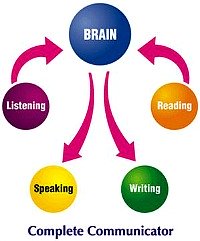 |
Learn English Locally, Apply It Worldwide! Enjoy Regular Practice |
Whole Brain Teaching
Bringing Teaching Heaven to Earth!
I'm honoured to be able to introduce Whole Brain Teaching (WBT) to you here. If you want to manage your students more effectively, still in a fun and engaging way and deliver your class so that it goes straight into their long-term memory bank, read on. Apply and enjoy!
The Whole Brain Teaching secret
Why was WBT introduced and why do you think it got so popular in the last half a century?
The beauty of the WBT secret is its simplicity: if a student's whole brain is engaged in learning, then there isn't any area left over for challenging behaviour. Think about it...
When we revert to punishing challenging behaviour it's not because we want to, but because we can't find anything else to do about it. But if we look at their challenging behaviour from the student's angle with sufficient compassion and understanding, we can realise that most of the challenging kids genuinely want to be part of the class. That's why they're trying so hard to get everyone's attention. They have a lot of energy for this disruptive activity, but... if you know how, you can put this energy to good use in the learning arena. WBT brings the tools.
The Whole Brain Teaching tools
The Whole Brain Teaching system was designed with two goals in mind: classroom management and effective teaching. To address the difficulty of the various methods applied by the teacher going stale in time, WBT is set up in levels, like a video game. If you stay at each level as long as you can (for weeks and even months at a time, before introducing a new level), you can make your teaching fun beyond October, January and even May! It's a long year...
The WBT year-long classroom management system is organised on 6 levels of teacher-student interaction, which are meant to keep everyone in check even during the most challenging times. They range from the most simple of methods to more and more complex. However, it is estimated that 80% of classroom management problems can be solved at the first 2 levels.
- The Scoreboard
- The Practice Cards (White, Purple and Green Cards)
- Guff Counter
- Independents
- Bull's Eye Game
- The Agreement Bridge
Apart from this we have 7 daily techniques, called The Big Seven, to implement in order to constantly use most of the students' brain areas during each class, no matter on the subject you're teaching.
- Class-Yes = The attention getter
- The Five Classroom Rules = The organiser
- Teach-OK = The whole brain activator
- The Scoreboard = The motivator
- Hands and Eyes = The focuser
- Switch = The involver
- Mirror = The unifier
Life is but a game, so roll the dice and let us play!
The WBT system is devised as a big, lively game, full of rewards and penalties, just like in a boardgame of Monopoly. Traditional teaching is based on a game as well, a dry one, where students see the rewards and penalties only after some tests or exams or at the end of the term, when they need to take their points home to their parents, in the form of marks on some test papers or in a Student Passport, etc. That's boring and off-putting.
With the WBT game you keep your students tiptoed virtually every minute, dashing to and fro on the Scoreboard, in a race for more rewards. You reward personal improvement, rather than some competitive, unfriendly behaviour. Even the penalties are entertaining, thus keeping the students' brains constantly engaged. Everybody in your class knows that the more they accumulate individual rewards, these are accumulated collectively for the whole class and then they are all getting to share the fun at the end. The fun will be something like a game of Mind Soccer, Word Bingo or other games the teacher considers useful.
English Corner Weekly E-zine
Packed with knowledge, published on Tuesdays.
Get yours here!
Our Archives:
Our lessons in the names and sounds of letters, short & long vowel sounds, CVCs, CCVCs, CVCCs, sight words, vowel and consonant contrasts, etc.
Our lessons will help increase your vocabulary, word recognition, find meaning in context, skills for TOEFL tests and other games, for fun.
Here we shall build some lessons to help you improve your writing skills.
Lots of lessons: cause & effect, comparisons, linking signals, relative clauses, presenting information, expressing emotions and grammar games, of course. We had more lessons on: intensifying adverbs and phrasal verbs, expressing various concepts such as addition, exception, restriction and ambiguity. Lately we started some exercises: likes/dislikes, frequency adverbs (twice), verb tenses, etc.
Learn how to build a website, by using the SBI! system - start from the basics, developing a site concept and a niche, supply and demand, learn about profitability and monetization, payment processing, register domain, website structure and content as a pyramid. Also learn about the tools I'm using to build this website. We also covered how to build traffic, working with search engines, building a good system of inbound links, using social marketing and blogs with the SBI system, how to use Socialize It and Form Build It, how to publish an e-zine and how to build a social network in your niche.
We looked at a few games by now: Countable & uncountable nouns, Free Rice, Name That Thing, Spell It, Spelloween, the Phrasal Verbs Game, Preposition Desert, The Sentence Game, Word Confusion, Word Wangling, Buzzing Bees, and The Verb Viper Game.
Be prepared to play and learn more pretty soon.
